Anthony Quinn started as a contract player at Paramount, where he mainly played villains and ethnic types. He moved to Broadway and replaced Marlon Brando in 'A Streetcar Named Desire'. This performance boosted his film career. For his role as Brando's brother in Viva Zapata! (Elia Kazan, 1952), Quinn won the Best Supporting Actor Academy Award. He gave one of his best performances as the circus strongman in Federico Fellini's masterpiece La Strada (1954). Quinn won his second Supporting Actor Oscar in 1957 for his role as Gauguin in Lust for Life (Vincente Minnelli, 1956), opposite Kirk Douglas as Vincent van Gogh. Over the next decades, Quinn alternated between Hollywood and European cinema, a drifter like Hugo Fregonese.
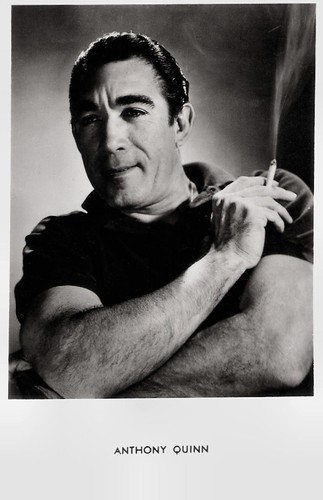
Dutch postcard, no. GR-5082.
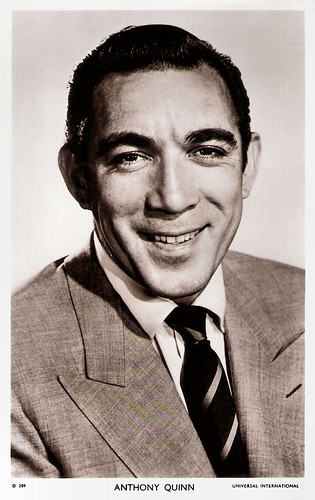
British postcard in the Picturegoer Series, London, no. D. 209. Photo: Universal International.

British postcard in the Picturegoer Series, London, no. D. 213. Photo: Universal International. Anthony Quinn and Ann Blyth in The World in his Arms (Raoul Walsh, 1952).
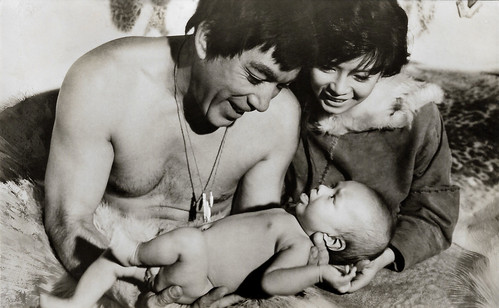
West-German card Photo: Rank Film. Anthony Quinn and Yoko Tani in The Savage Innocents (Nicholas Ray, 1959).
The Son-in-law of Cecil B. DeMille
Antonio Rudolfo Oaxaca Quinn was born in 1915, in Chihuahua, Mexico. His parents were Manuela (Oaxaca) and Francisco Quinn. After starting life in extremely modest circumstances in Mexico, his family moved to Los Angeles, where his father became an assistant cameraman at the Selig Film Studios. Quinn often accompanied his father to work and became acquainted with such stars as Tom Mix and John Barrymore, with whom he kept up the friendship into adulthood.
He attended Polytechnic High School and later Belmont High, but eventually dropped out. The young Quinn boxed which stood him in good stead as a stage actor, when years later, he played Stanley Kowalski in 'A Streetcar Named Desire'. He won a scholarship to study architecture under Frank Lloyd Wright at the great architect's studio, Taliesin, in Arizona. Quinn was close to Wright, who encouraged him when he decided to give acting a try.
After a brief apprenticeship on stage, Quinn hit Hollywood. He made his film debut with a character role in the crime drama Parole! (Lew Landers, 1936). Quinn picked up a variety of small roles in several films at Paramount, including a Cheyenne Indian in The Plainsman (1936), which was directed by his future father-in-law, Cecil B. DeMille. As a contract player at Paramount, Quinn mainly played villains and ethnic types, such as a gangster in the crime drama Dangerous to Know (Robert Florey, 1938), a Chinese gangster in Island of Lost Men (Kurt Neumann, 1939) and an Arab chieftain in the Bing Crosby-Bob Hope vehicle Road to Morocco (David Butler, 1942). He also played the sympathetic Crazy Horse in They Died with Their Boots On (Raoul Walsh, 1941) with Errol Flynn.
As a Mexican national (he did not become an American citizen until 1947), he was exempt from the draft. With many actors in the service fighting World War II, Quinn was able to move up into better supporting roles. He had married DeMille's daughter Katherine DeMille, which afforded him entrance to the top circles of Hollywood society. However, he became disenchanted with playing supporting parts as Chief Yellow Hand in Buffalo Bill (William A. Wellman, 1944) and a Chinese in China Sky (Ray Enright, 1945). His first lead was the Indian farmer Charlie Eagle in Black Gold (Phil Karlson, 1947) opposite his wife, Katherine DeMille.
By 1947, he had appeared in more than fifty films and was still not a major star. He did not renew his Paramount contract despite the advice of others, including his father-in-law whom Quinn felt never accepted him due to his Mexican roots. Instead, he returned to the stage. His portrayal of Stanley Kowalski in 'A Streetcar Named Desire' in Chicago and on Broadway, where he replaced Marlon Brando, made his reputation.
However, IMDb also gives another explanation for his move to the stage: “Became a naturalized United States citizen in 1947, just before he was ‘gray-listed’ for his association with Communists such as screenwriter John Howard Lawson and what were termed ‘fellow travellers’, though he himself was never called before the House of Un-American Activities Committee. When warned of his gray-listing by 20th Century-Fox boss Darryl F. Zanuck (a liberal), Quinn decided to go on the Broadway stage where there was no blacklist rather than go through the process of refuting the suspicions.”

British postcard in the Picturegoer Series, London, no. 1380. Photo: Paramount.
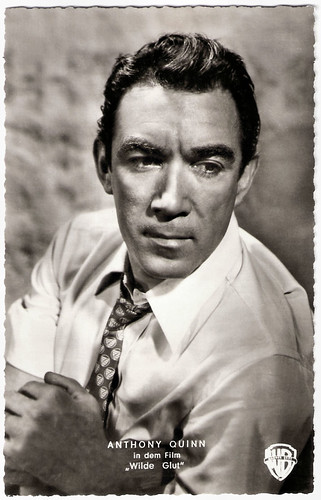
German postcard by Kunst und Bild, no. T 882. Photo: Warner Bros. Publicity still for Blowing Wild (Hugo Fregonese, 1953).

Dutch postcard by N.V. v.h. Weenenk & Snel, Baarn, no. 360. Photo: Paramount. Anthony Quinn in Hot Spell (Daniel Mann, 1958).

French postcard by Editions P.I. / Humour à la Carte, Paris, no. 3356. Photo: United Artists.
The first Mexican-American Oscar winner
Anthony Quinn’s success on Broadway boosted his film career. He returned to the cinema in The Brave Bulls (Robert Rossen, 1951). Director Elia Kazan then cast him as Marlon Brando's brother in his biographical film of Mexican revolutionary Emiliano Zapata, Viva Zapata! (1952). Quinn won the Best Supporting Actor Academy Award in 1952, making him the first Mexican-American to win an Oscar.
It was not to be his lone appearance in the winner's circle: he won his second Supporting Actor Oscar five years later for his portrayal of painter Paul Gauguin in Vincente Minnelli's biographical film of Vincent van Gogh, Lust for Life (1956), opposite Kirk Douglas.
Over the next decade, Quinn lived in Italy and became a major figure in world cinema, as many studios shot films in Italy to take advantage of the lower costs. He appeared in several Italian films, giving one of his greatest performances as the dim-witted, thuggish and volatile circus strongman who brutalises the sweet soul played by Giulietta Masina in her husband Federico Fellini's masterpiece La Strada (1954).
Alternating between Europe and Hollywood, Quinn built his reputation and entered the front rank of character actors and character leads. He received his third Oscar nomination (and first for Best Actor) for Wild Is the Wind (George Cukor, 1957). Quinn starred in The Savage Innocents (Nicholas Ray, 1959) as Inuk, an Eskimo who finds himself caught between two clashing cultures. He played a Greek resistance fighter against the Nazi occupation in the box office hit The Guns of Navarone (J. Lee Thompson, 1961) and received praise for his portrayal of a once-great boxer on his way down in Requiem for a Heavyweight (Ralph Nelson, 1962).
Back on Broadway, he was nominated for the 1961 Tony Award as Best Actor (Dramatic) for his part as King Henry II opposite Laurence Olivier as Thomas Becket in 'Becket' (Becket ou l'honneur de Dieu) by Jean Anouilh. He returned to the cinema to play ethnic parts, such as an Arab warlord in David Lean's masterpiece Lawrence of Arabia (1962), and he played the eponymous lead in the Sword-and-sandal blockbuster Barabbas (Richard Fleischer, 1961) opposite Silvana Mangano.
Two years later, he reached the zenith of his career, playing Zorba in Alexis Zorbas/Zorba the Greek (Michael Cacoyannis, 1964), which brought him his fourth, and last, Oscar nomination as Best Actor. The 1960s were kind to him: he played character leads in such major films as The Shoes of the Fisherman (Michael Anderson, 1968) opposite Laurence Olivier, and The Secret of Santa Vittoria (Stanley Kramer, 1969), with Anna Magnani. However, his appearance in the title role in the film adaptation of John Fowles' novel, The Magus (Guy Green, 1968), did nothing to save the film, which was one of that decade's notorious turkeys.

Italian postcard by Bromofoto, Milano, no. 1400. Photo: Paramount Films.

French postcard by E.D.U.G., no. 96.
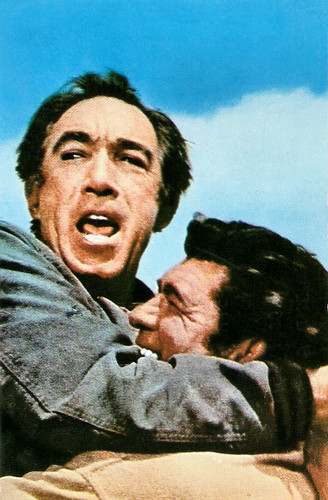
Romanian postcard by Casa Filmului Acin, no. 166. Photo: publicity still for Flap (Carol Reed, 1970).

Big East-German collectors card by Progress Film-Verleih, Berlin, no. 15/82.
Not an authentic black hero
The following decade saw Anthony Quinn slip back into playing ethnic types again. He starred as the Hispanic mayor of a rapidly growing city in the Southwest United States in the TV series The Man and the City (1971).
IMDb writes about an interesting incident: “Around 1972, he announced his desire to play Henry Cristophe, the 19th-century emperor of Haiti. Upon this announcement, several prominent black actors, including Ossie Davis and Ellen Holly, stated that they were opposed to a ‘white man’ playing ‘black’. Davis stated, ‘My black children need black heroes on which to model their behaviour. Henry Cristophe is an authentic black hero. Tony, for all my admiration of him as a talent, will do himself and my children a great disservice if he encourages them to believe that only a white man and Tony is white to my children, is capable of playing a black hero.’”
Quinn’s career lost its momentum during the 1970s. Aside from playing a thinly disguised Aristotle Onassis in the cinematic roman-a-clef The Greek Tycoon (J. Lee Thompson, 1978), his other major roles of the decade were as Hamza in the controversial The Message/Mohammad, Messenger of God (Moustapha Akkad, 1976), as the Italian patriarch in L'eredità Ferramonti/The Inheritance (Mauro Bolognini, 1976) opposite Dominique Sanda, yet another Arab in Caravans (James Fargo, 1978) and a Mexican patriarch in The Children of Sanchez (Hall Bartlett, 1978) with Dolores Del Rio.
In 1983 he reprised his most famous role, Zorba the Greek, on Broadway in the revival of the musical Zorba, for 362 performances. Though his film career slowed during the 1990s, he continued to work steadily in films and television, such as in the HBO original crime drama Gotti: The Rise and Fall of a Real Life Mafia Don (Robert Harmon, 1996). Quinn lived out the latter years of his life in Bristol, Rhode Island, where he spent most of his time painting and sculpting. His final film was the Sylvester Stallone vehicle Avenging Angelo (Martyn Burke, 2002).
In 2001, Anthony Quinn died in a hospital in Boston from pneumonia and respiratory failure linked to his battle with lung cancer. Quinn was 86 years old. He was married three times. After divorcing Katherine DeMille in 1965, he married Italian costume designer Jolanda Addolori (1966-1997) and after their divorce his secretary, Kathy Benvin (1997-2001). He had ten children, five with DeMille, three with Addolori, and two with Benvin.

Romanian postcard by Casa Filmului Acin. Photo: publicity still for Flap (Carol Reed, 1970).

Romanian postcard by Casa Filmului Acin, no. 43078.
Trailer La Strada (1954). Source: Blondinka Inoz (YouTube).
Trailer Alexis Zorbas/Zorba the Greek (1964). Source: Fernando Braz (YouTube).
Trailer The Shoes of the Fisherman (1968). Source: Movieclips Trailer Vault (YouTube).
Sources: Jon C. Hopwood (IMDb), Pedro Borges (IMDb), Wikipedia, and IMDb.
No comments:
Post a Comment